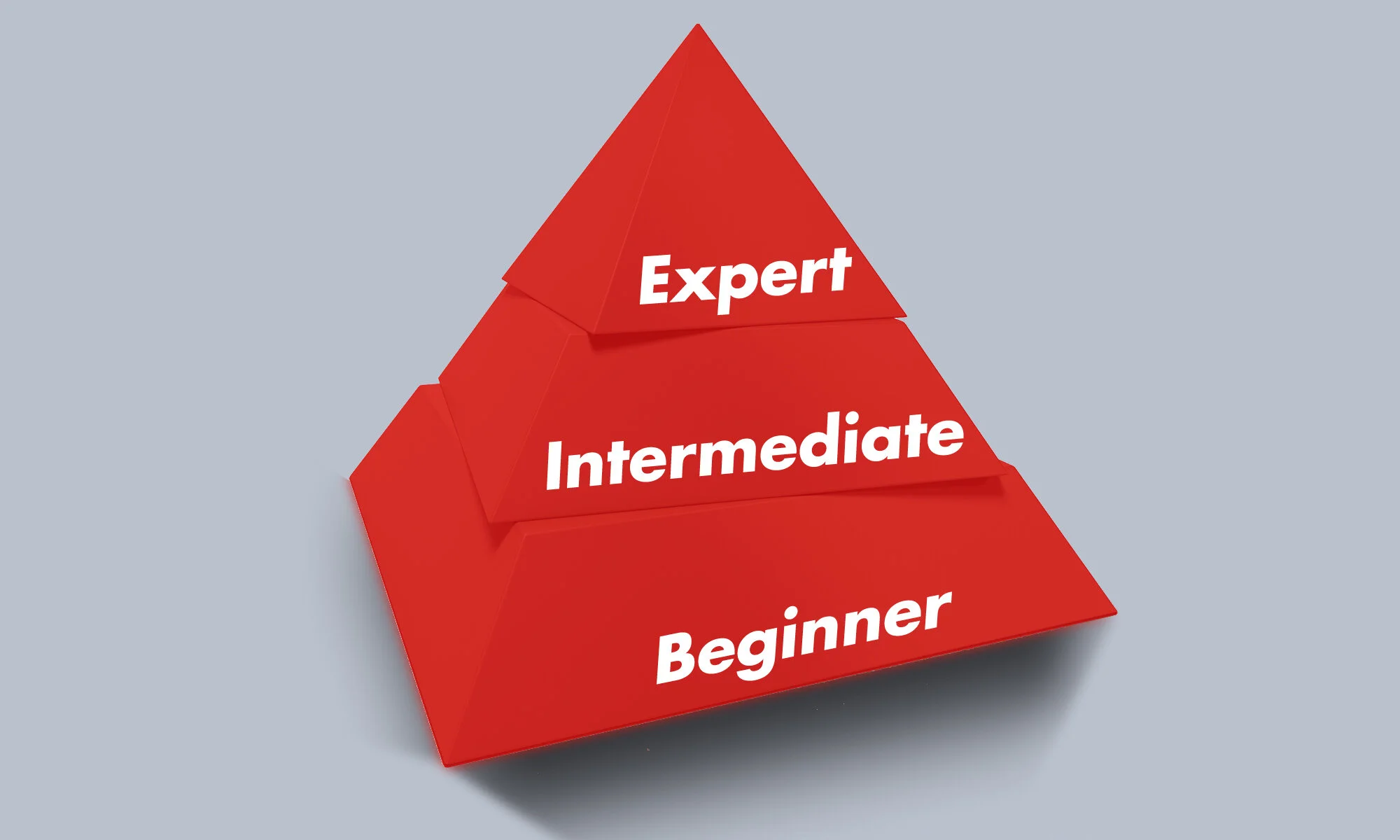By: Sue Ebbers, Ph.D.
Originally published on October 20, 2020
Updated on October 12, 2023
Before building a house, it is necessary to design it. To design a house, you hire an architect. An architect is someone who thoroughly understands the theory, models and strategies related to delivering a robust structure that meets the buyer’s requirements and any building codes. They are working from experience, but also avoiding damaging assumptions or biases that are cultivated internally.
The same is true when designing full curricula, if an organization seeks a comprehensive workforce skill development intervention whose structure is sound. This is part 3 of a 3-part blog article series that concludes how to achieve workforce alignment to the requirements of your organization.
In this example used in the article series, the entire skill set had to be designed and developed for each of three levels of sales associate. After a comprehensive set of validated competencies were identified for each level, it was essential to design the curriculum architecture before the client could create individual trainings.
Top 5 Key Elements To Consider In Curriculum Architecture
Whether you are designing one course or a suite of courses, be sure to consider the following critical aspects of a curriculum, based on this project example:
Target Audiences
For an sales expert to benefit from their training, a completely different ‘smorgasbord’ approach was required that included a variety of learning inputs, such as a conference for all three levels of sales associate, mentorship requirements with new sales associates, and “Beginning for Experts” training for review and to keep the basic skill set fresh.
Environments
Effective instructional design requires consideration of two environments: 1) where learning takes place, and 2) where the skills and knowledge learned will be in operation. It’s so important to deliver a learning experience that authentically represents work life, so that learning will expectedly be transferred from one environment (virtual, like in an online LMS) to the other (actual). The key here for the example was making the learning environment strongly representative of the environment where the sales associates operated. For this example project, and in others like it, the solution Change By Design tends to recommend is authentic case-based learning and simulations. However, for novices and intermediate learners, the recommendation also includes a heavy focus on mentorship by experts as well as peer-to-peer support.
Skill Sequencing And Prerequisites
By this point, the developer of the competency model understood the content so well, that they could almost become an effective beginning sales associate for the client. This understanding is an essential key to Change By Design’s instructional design success. Truly effective instruction design must weave within the architecture a story-like logic for learners, so they see the obvious connections among learning activities and their sequencing. Similarly to how humans enjoy telling and listening to stories with a beginning, middle and end, the brain craves logic within learning architectural designs. Effective designers lay out competency tasks as learning objectives in the correct learning sequence. They deliver prerequisite skills and knowledge in advance so new material is well-received, and they insert what must be learned first at the beginning, then proceed to build upon this through each new item to be learned. This is an important way Change By Design ensures learning ‘sticks’ with the learner.
Success Criteria
Some organizations develop performance solutions before they understand the features of the problem which must be addressed. It’s vitally important that you do not skip over this crucial step, because these criteria are the building blocks to solving the problem. For example, expert sales associates listed the following success criteria for whatever comprehensive learning solution Change By Design would develop. These included:
Sharpen their competitive edge.
Swap ideas with other expert sales associates.
Develop deep insight and intuitive ability to help each customer.
Lead the way.
Solve customer problems.
Live ‘in relationship’ with all.
Armed with that understanding of the success criteria, Change By Design was able to evaluate ideas and options to determine the optimal solutions.
Return On Investment - ROI
No organization has unlimited revenue. Every dollar must be carefully weighed against its strategic value. We look at costs, as compared to benefits, to determine the right solution for all factors. This is the final essential aspect of designing and implementing a curriculum architecture, so that you can deliver a right-sized solution in terms of budget and return.
Comparing The Curriculum Architecture Across Multiple Competency Levels
This is a brief look at the learning architectural designs that Change by Design delivered to the client for the example project, starting with the beginning sales associate and proceeding to the expert. Click each of the levels to review the designs.
+ Beginner Sales Associate
For the ‘novice’, or beginning sales associate learner, Change By Design developed two sets of recommendations. The first was the reduced recommendations that aligned best with the budget; the second was the ‘full blown’ version given ideal conditions. In both cases, the architecture consisted of three main components:
- Practicum/Lab Guide
- eLearning and virtual instructor-led (vILT) courses
- Instructor-Led Trainings (ILT)
For this curriculum architecture, as well as for that of the intermediate and expert sales associate curriculum architectures, Change By Design developed a number of flowcharts sequencing all relevant content. Competencies with modified wording now served as learning objectives; these learning objectives were then sequenced in alignment with the learner’s growing “mental model” of the beginning sales associate role.
Change By Design also broke up the curriculum into “chunks” of content to be instructed and identified the type of instruction it would be (practicum, eLearning, vILT, or ILT). The client received an overview explanation of each ‘chunk’ and an ordering of related competencies. Analysis information provided included:
- Course seat time.
- Inclusion in practicum or not.
- eLearning, vILT, ILT.
- Content complexity.
- Prioritization with other content to help the client make cost-related decisions (low, medium, high priority).
- Overview rationale regarding the instructional requirements for the content and its sequencing.
While the beginning sales associate curriculum was akin to a year-long deep dive apprenticeship, the intermediate curriculum was developed to more closely resemble a self-paced college course.
+ Intermediate Sales Associate
The structure we recommended followed this pattern:
- eLearning
- Case-based Prework
- Virtual Instructor-Led classes
- Instructor-led training
Although mentorship was a key component in the beginning sales associate curriculum, the intermediate curriculum had no ongoing mentorship component, but rather focused a segment of their effort on peer-to-peer support and learning.
Intermediate eLearnings were deeper dives into the content found within the beginning curriculum. Case-based PreWork was included to provide all corrective feedback, replacing the practicum. However, through careful coursework evaluation, it was determined that some of the PreWork activities should not have embedded corrective feedback, but should instead be debriefed in vILT classroom settings. Also, learners would be required to pass brief assessment activities at 90% as a gateway activity through which they would need to pass to gain entrance to vILT and ILT sessions.
The two ILT sessions were framed as skill consolidation simulations, where the center of class power was again placed squarely in the hands of learners. Prior to the second ILT session, learners were required to read three key books and participate in a weekly threaded online discussion over a six month period. These discussions, as well as the close connections developed among learners within the ILT sessions, where designed to enable a stronger shared mental model and foster close collegial ties. These are the ties that would yield a cohesive network of very competent sales associates throughout North America.
The intermediate sales associates curriculum was designed specifically to create greater independence in the learners. That effort was extended even further within the expert sales associate curriculum.
+ Expert Sales Associate
Upon completion of Change By Design’s extensive analysis, the conclusion was that expert sales associates could not be further developed using a traditional training approach. An expert becomes an expert because they already have a specific aptitude. However, the research did identify a specific area of development for the expert curriculum. These individuals strongly valued an opportunity to serve as mentors, and to review prior learned material so that they could stay on top of their game as sales professionals. The goal here was for them to sell even more products faster through their well-developed client relationships.
This article series earlier mentioned the essential solution criteria in terms of building capacity in expert sales associates. An additional step for this curriculum was to combine the expert-level competencies that needed to be supported. The goals identified were supporting three skill sets:
- Solving customer problems creatively, which combined the following competencies: deep understanding of external business and industry influences, a deep dive on a consulting approach and an effective problem-solving approach.
- Selling through deep understanding, which not only included other KSA under the three competencies just listed, but also looking at how to walk in the customer’s shoes, and understanding the psychology of motivation.
- Maintaining and growing one’s customer portfolio, which included being able to approach potential customers through relationship-based and consulting foci.
Change By Design’s approach for the client was multi-pronged. There were a total of eight recommendations, of which four have been included below to serve as examples:
- Deliver a conference (perhaps every three years) for all levels of sales associate to support cross-pollination of ideas and support the expert’s desire to mentor newer sales associates to sharpen their current skill set. Using expert sales associates as speakers during general sessions, similar to the TED talk format, would be one way to impart understanding among all. Change By Design provided very specific guidance on all success requirements.
- Pairing experts with new sales associates as one requirement to retain their ‘expert’ designation, which was coveted within the organization.
- Bring in all competitor products for a look, feel and discussion event.
- Delivering an ‘Intermediate For Experts’ training, where they actually return to take that curriculum along with true intermediate learners.
Summary Conclusion
Instructional designers who deliver effective results spare no effort in their research, analysis, and recommendations to meet the requirements inherent within a client project. Competency models developed are highly precise, and delivered using a 360-degree approach. In the example discussed, it should be clear that the client sought a comprehensive performance solution, which was derived through extreme rigor - including targeted surveys which helped uncover startling insights. A comprehensive approach like the methodology outlined in this blog article series is not always necessarily required for every workplace.
However, there are many organizations whose mission or goals include persevering through health-critical risk, emergency life & death, and high financial loss value situations. In workforce development areas like law enforcement, medical-related categories, social service-related roles and military agencies, the wrong training can lead to staggering, negative consequences.
This methodology also serves as the evidence-based, system-thinking foundation for the following types of workforce-related activities, which Change By Design can deliver in alignment with the organization’s requirements:
Development of job descriptions
Development of organizational performance standards in alignment with such national and international standards as ISO
Internal behavioral auditing checklists
Performance evaluations
Workforce design and development in alignment with competency model specifications, as well as with desired organizational results
Alignment of personality traits to job competencies to determine best fit
Succession planning through workforce development/preparation
Item writing, state- or country-wide item sampling, review workshops, and pilot testing
Development of equivalent exams
Psychometric analysis
Download the .pdf of this case study blog series in a printable white paper format
Re-read part 2 of this blog series (gap analysis)
Re-read part 1 of this blog series (introduction)
Related Articles For Further Reading
Consider subscribing to our email newsletter today to automatically receive the next issue in your inbox, including our most recent authored articles.









